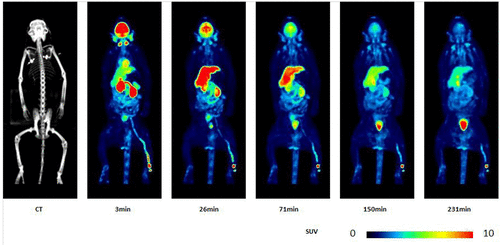当前位置:
X-MOL 学术
›
ACS Chem. Neurosci.
›
论文详情
Our official English website, www.x-mol.net, welcomes your
feedback! (Note: you will need to create a separate account there.)
Synthesis, Biodistribution, and Radiation Dosimetry of a Novel mGluR5 Radioligand: 18F-AZD9272.
ACS Chemical Neuroscience ( IF 4.1 ) Pub Date : 2020-03-24 , DOI: 10.1021/acschemneuro.9b00680 Sangram Nag 1 , Katarina Varnäs 1 , Ryosuke Arakawa 1 , Mahabuba Jahan 2 , Magnus Schou 1, 3 , Lars Farde 1 , Christer Halldin 1, 4
ACS Chemical Neuroscience ( IF 4.1 ) Pub Date : 2020-03-24 , DOI: 10.1021/acschemneuro.9b00680 Sangram Nag 1 , Katarina Varnäs 1 , Ryosuke Arakawa 1 , Mahabuba Jahan 2 , Magnus Schou 1, 3 , Lars Farde 1 , Christer Halldin 1, 4
Affiliation

|
The metabotropic glutamate receptor subtype mGluR5 has been proposed as a potential drug target for CNS disorders such as anxiety, depression, Parkinson’s disease, and epilepsy. The AstraZeneca compound AZD9272 has previously been labeled with carbon-11 and used as a PET radioligand for mGluR5 receptor binding. The molecular structure of AZD9272 allows one to label the molecule with fluorine-18 without altering the structure. The aim of this study was to develop a fluorine-18 analogue of AZD9272 and to examine its binding distribution in the nonhuman primate brain in vivo as well as to obtain whole body radiation dosimetry. 18F-AZD9272 was successfully synthesized from a nitro precursor. The radioligand was stable, with a radiochemical purity of >99% at 2 h after formulation in a sterile phosphate buffered solution (pH = 7.4). After injection of 18F-AZD9272 in two cynomolgus monkeys, the maximum whole brain radioactivity concentration was 4.9–6.7% of the injected dose (n = 2) and PET images showed a pattern of regional radioactivity consistent with that previously obtained for 11C-AZD9272. The percentage of parent radioligand in plasma was 59 and 64% (n = 2) at 120 min after injection of 18F-AZD9272, consistent with high metabolic stability. Two whole body PET scans were performed in nonhuman primates for a total of 231 min after injection of 18F-AZD9272. Highest uptakes were seen in liver and small intestine, followed by brain and kidney. The estimated effective dose was around 0.017 mSv/MBq. 18F-AZD9272 shows suitable properties as a PET radioligand for in vivo imaging of binding in the primate brain. 18F-labeled AZD9272 offers advantages over 11C-AZD9272 in terms of higher image resolution, combined with a longer half-life. Moreover, based on the distribution and the estimated radiation burden, imaging of 18F-AZD9272 could be used as an improved tool for quantitative assessment and characterization of AZD9272 binding sites in the human brain by using PET.
中文翻译:

新型mGluR5放射性配体的合成,生物分布和辐射剂量:18F-AZD9272。
已经提出了代谢型谷氨酸受体亚型mGluR5作为中枢神经系统疾病(如焦虑症,抑郁症,帕金森氏病和癫痫症)的潜在药物靶标。阿斯利康的化合物AZD9272先前已被碳11标记,并用作PET放射性配体来与mGluR5受体结合。AZD9272的分子结构允许人们在不改变结构的情况下用氟18标记分子。这项研究的目的是开发AZD9272的氟18类似物,并检查其在非人类灵长类动物体内的结合分布,以及获得全身辐射剂量。18岁F-AZD9272是由硝基前体成功合成的。放射性配体是稳定的,在无菌磷酸盐缓冲溶液(pH = 7.4)中配制后2 h,放射化学纯度> 99%。在两只食蟹猴中注射18 F-AZD9272后,最大全脑放射性浓度为注射剂量的4.9–6.7%(n = 2),PET图像显示的区域放射性与先前对11 C-获得的放射性一致AZD9272。注射18次后120分钟血浆中母体放射性配体的百分比分别为59%和64%(n = 2)F-AZD9272,具有较高的代谢稳定性。注射18 F-AZD9272后,在非人灵长类动物中进行了两次全身PET扫描,总计231分钟。在肝脏和小肠中摄取最多,其次是脑和肾。估计的有效剂量约为0.017 mSv / MBq。图18F-AZD9272显示出作为PET放射性配体的合适性质,用于体内成像灵长类动物脑中的结合。18 F标记的AZD9272与11 C-AZD9272相比,在更高的图像分辨率和更长的半衰期方面具有优势。此外,根据分布和估计的辐射负荷,对18F-AZD9272可以用作改进的工具,通过使用PET定量评估和表征人脑中AZD9272结合位点。
更新日期:2020-03-24
中文翻译:

新型mGluR5放射性配体的合成,生物分布和辐射剂量:18F-AZD9272。
已经提出了代谢型谷氨酸受体亚型mGluR5作为中枢神经系统疾病(如焦虑症,抑郁症,帕金森氏病和癫痫症)的潜在药物靶标。阿斯利康的化合物AZD9272先前已被碳11标记,并用作PET放射性配体来与mGluR5受体结合。AZD9272的分子结构允许人们在不改变结构的情况下用氟18标记分子。这项研究的目的是开发AZD9272的氟18类似物,并检查其在非人类灵长类动物体内的结合分布,以及获得全身辐射剂量。18岁F-AZD9272是由硝基前体成功合成的。放射性配体是稳定的,在无菌磷酸盐缓冲溶液(pH = 7.4)中配制后2 h,放射化学纯度> 99%。在两只食蟹猴中注射18 F-AZD9272后,最大全脑放射性浓度为注射剂量的4.9–6.7%(n = 2),PET图像显示的区域放射性与先前对11 C-获得的放射性一致AZD9272。注射18次后120分钟血浆中母体放射性配体的百分比分别为59%和64%(n = 2)F-AZD9272,具有较高的代谢稳定性。注射18 F-AZD9272后,在非人灵长类动物中进行了两次全身PET扫描,总计231分钟。在肝脏和小肠中摄取最多,其次是脑和肾。估计的有效剂量约为0.017 mSv / MBq。图18F-AZD9272显示出作为PET放射性配体的合适性质,用于体内成像灵长类动物脑中的结合。18 F标记的AZD9272与11 C-AZD9272相比,在更高的图像分辨率和更长的半衰期方面具有优势。此外,根据分布和估计的辐射负荷,对18F-AZD9272可以用作改进的工具,通过使用PET定量评估和表征人脑中AZD9272结合位点。











































 京公网安备 11010802027423号
京公网安备 11010802027423号